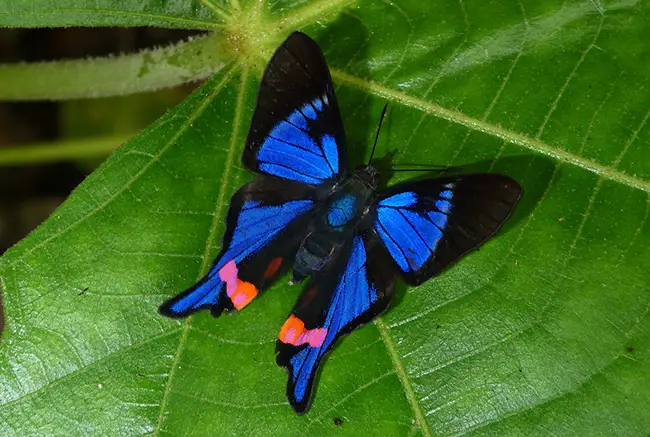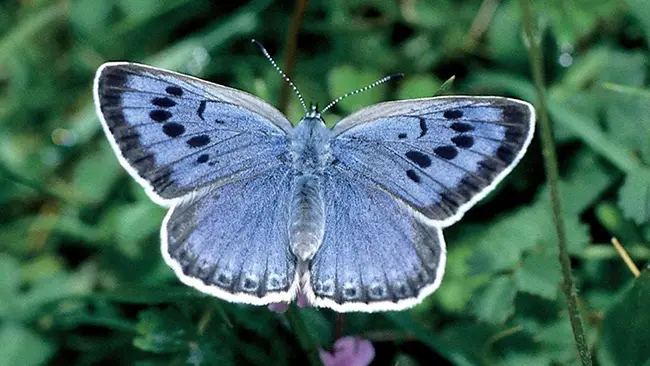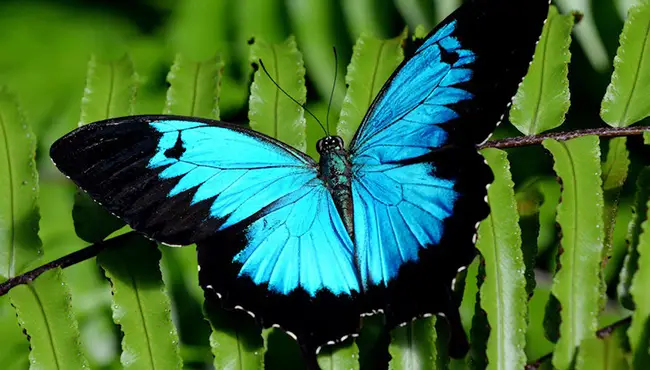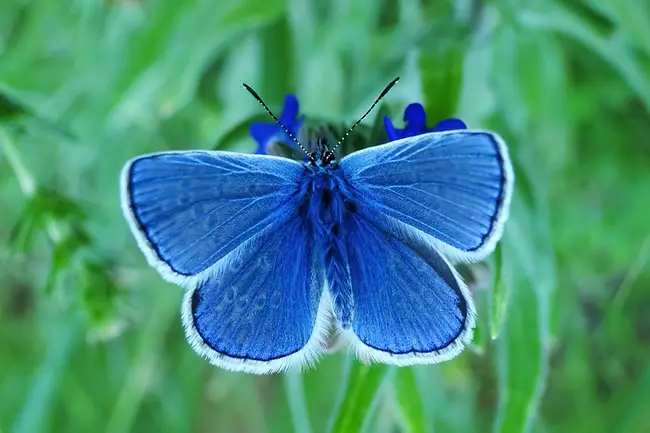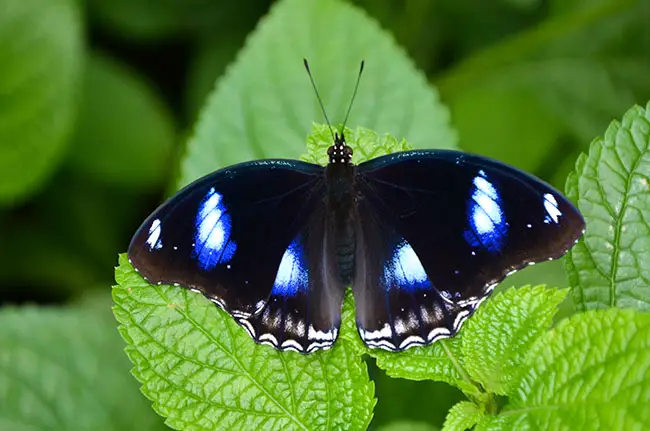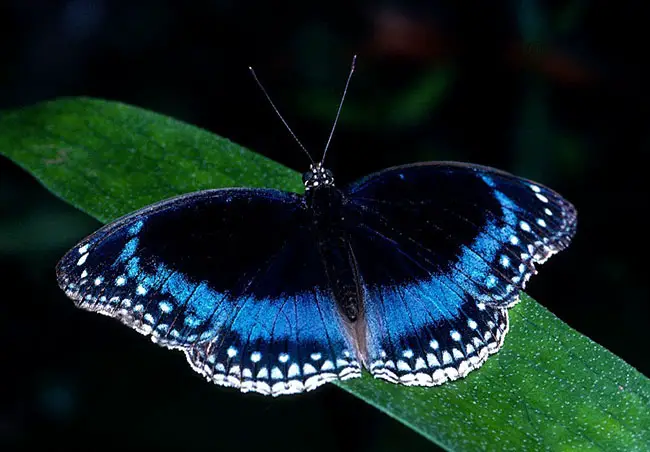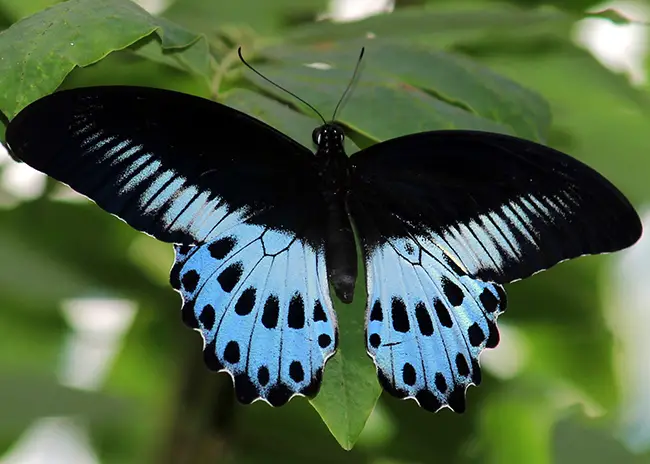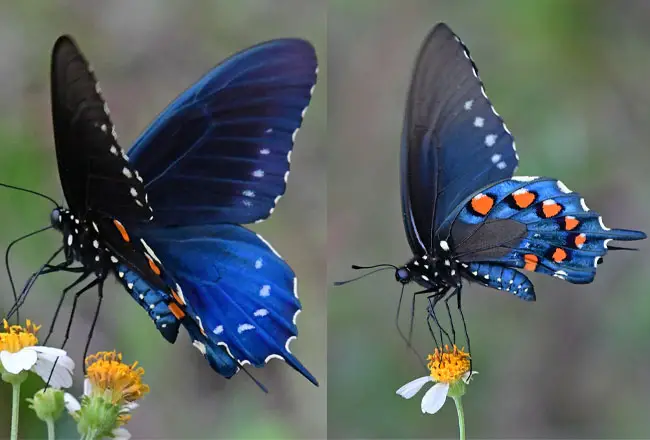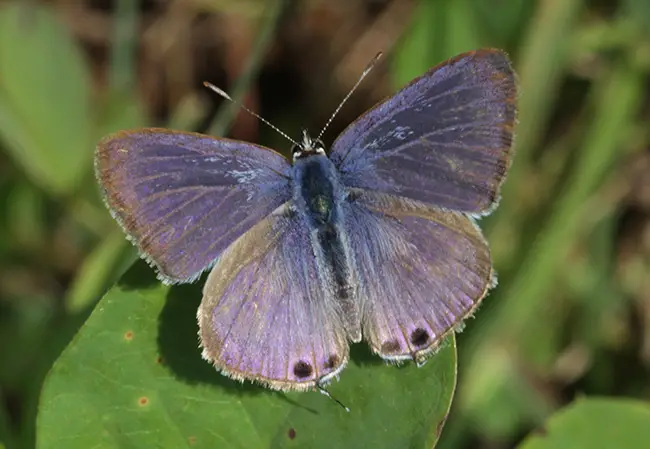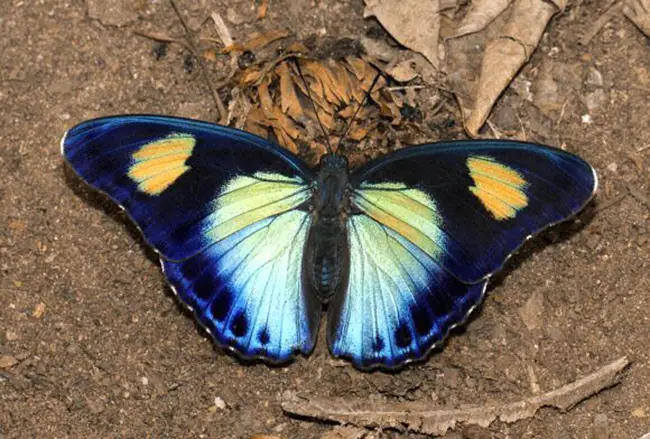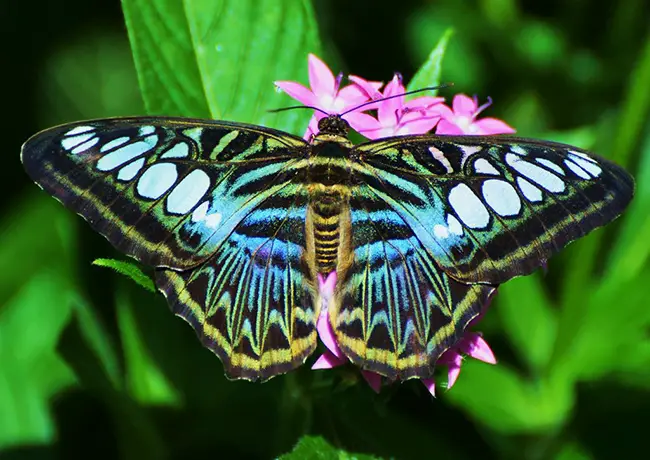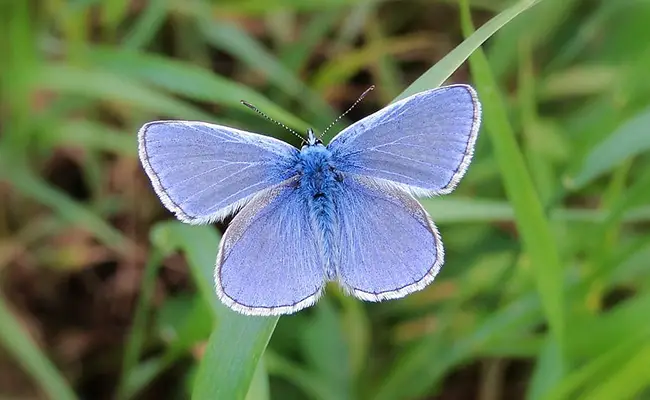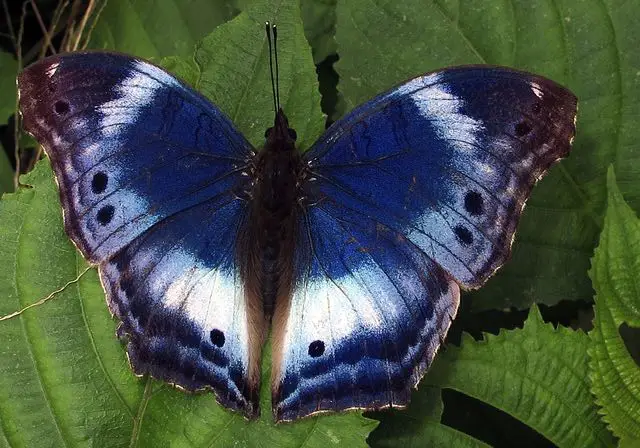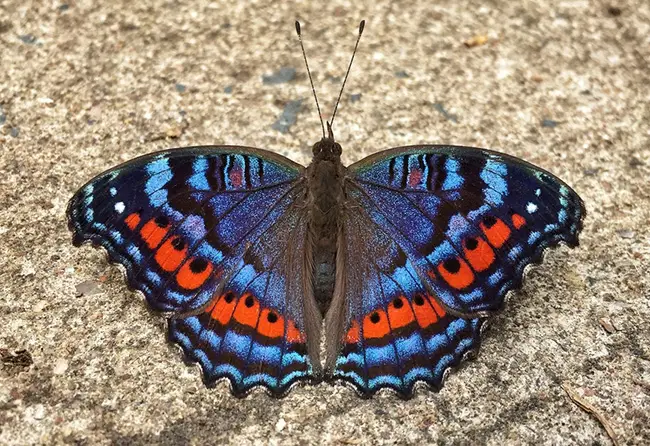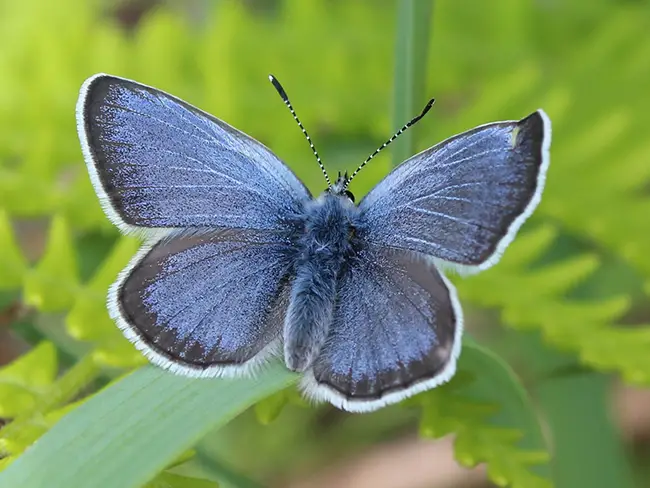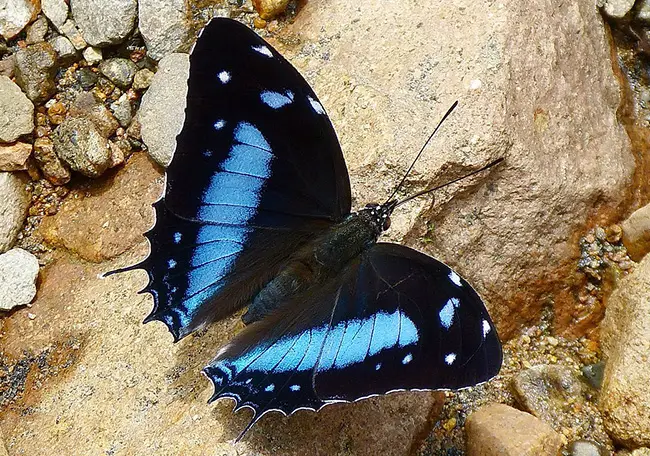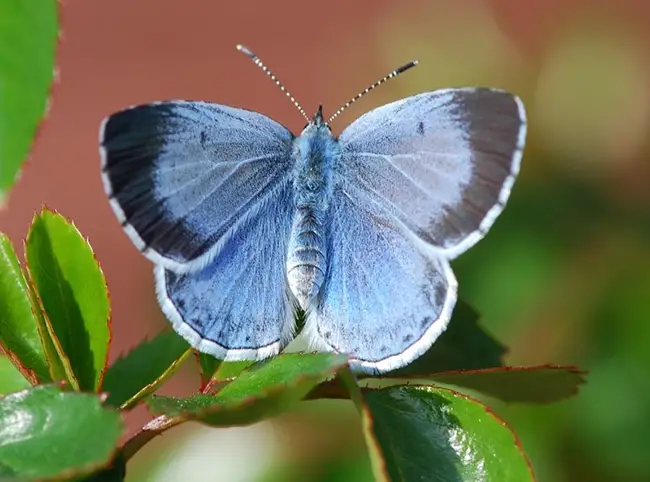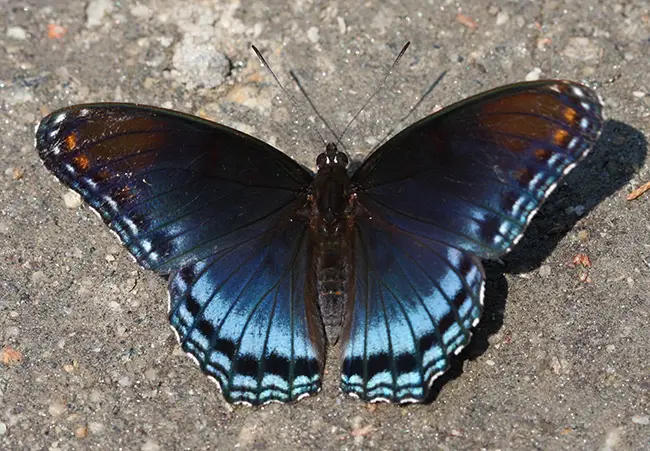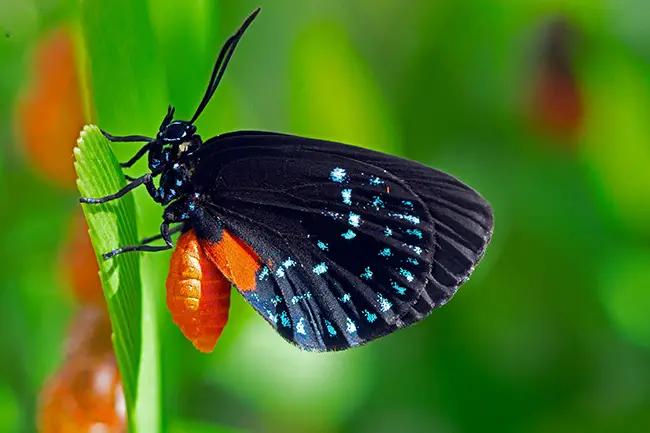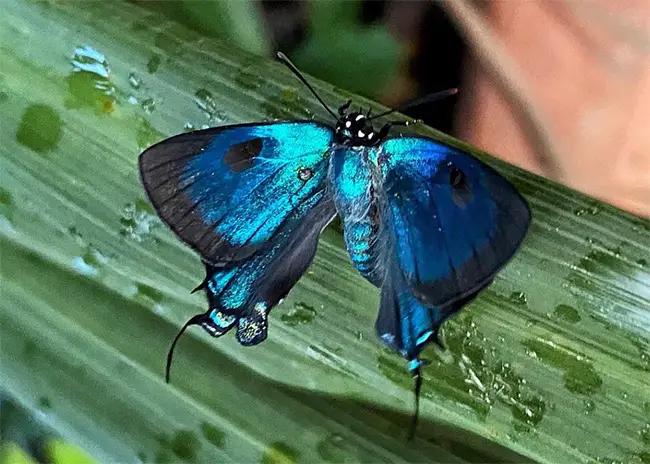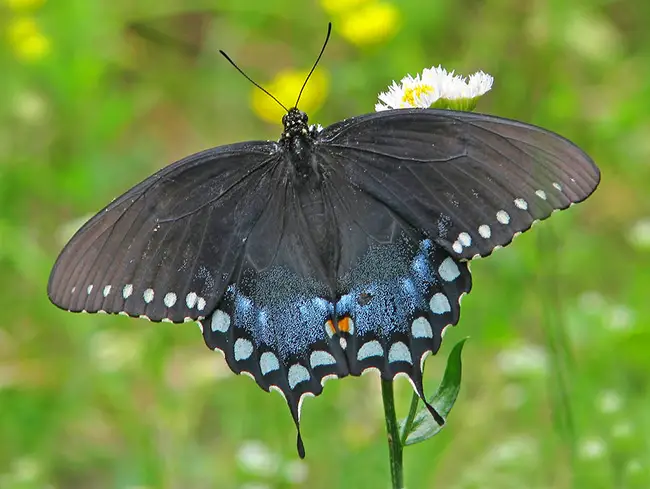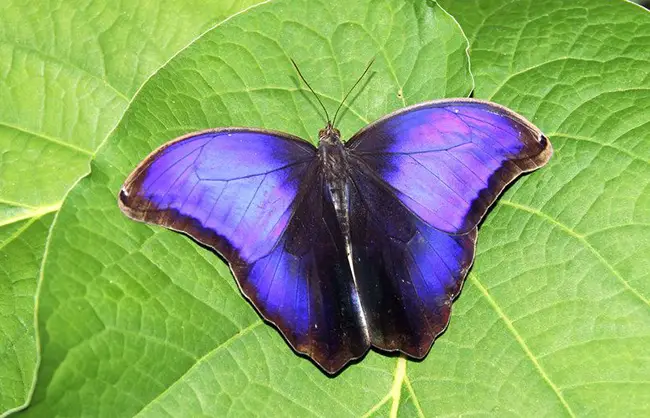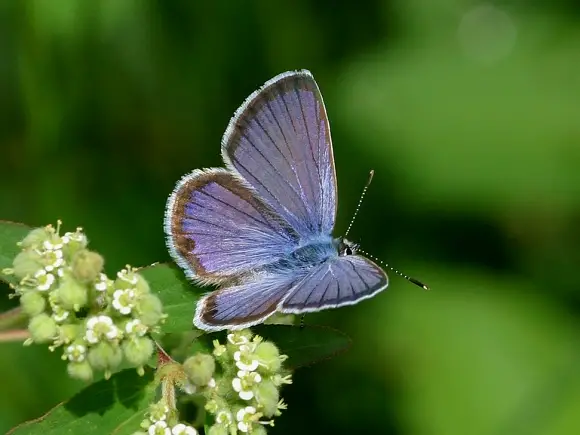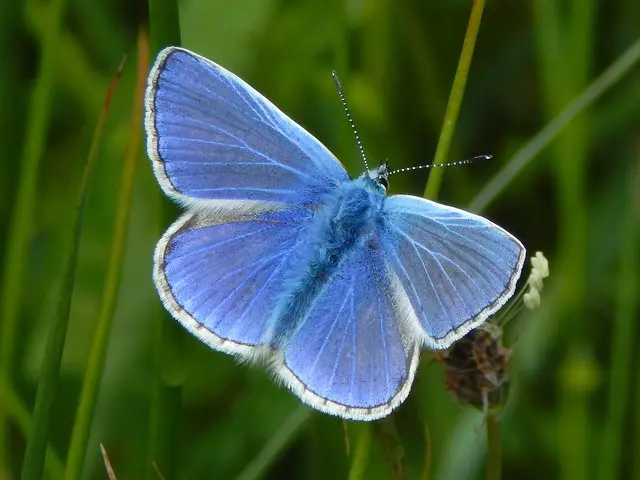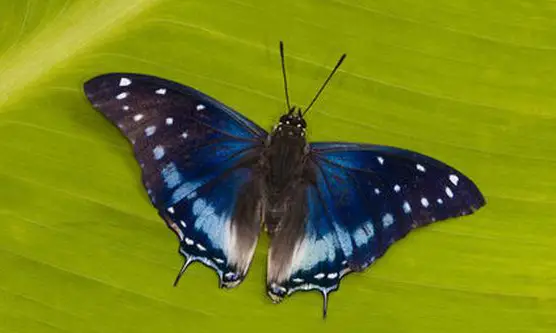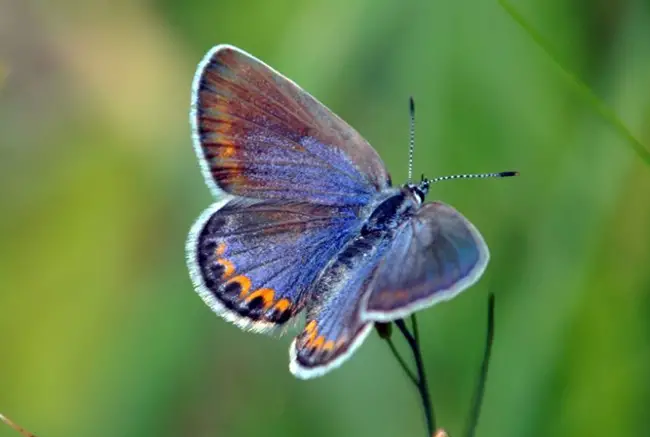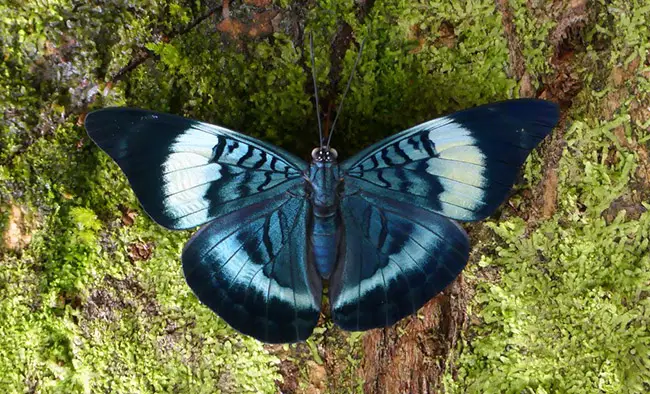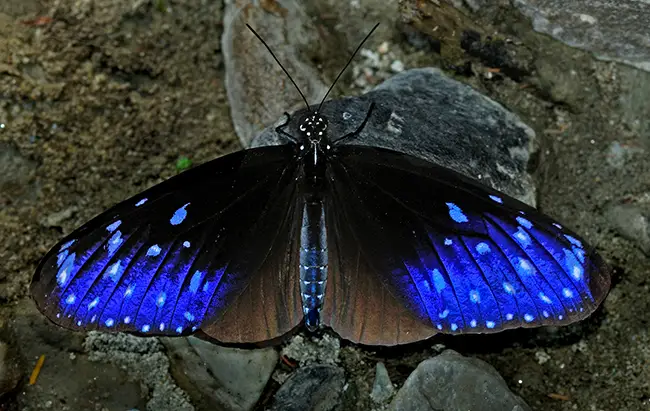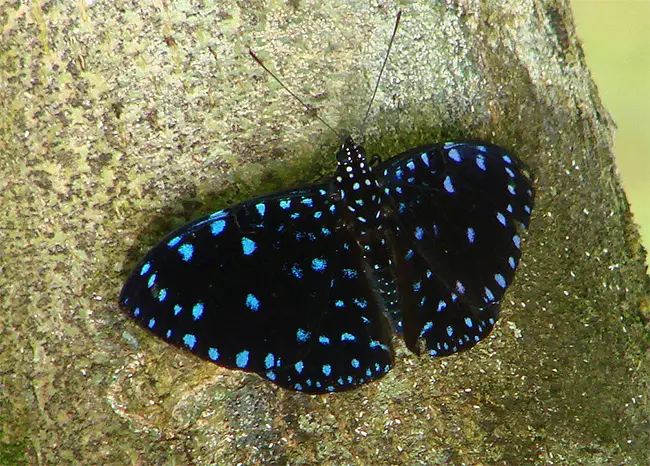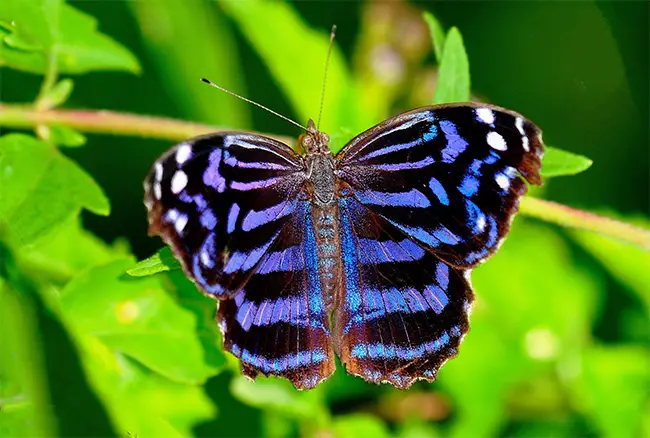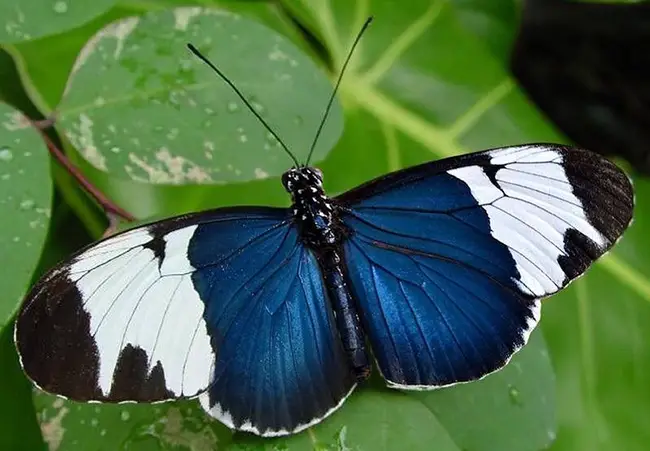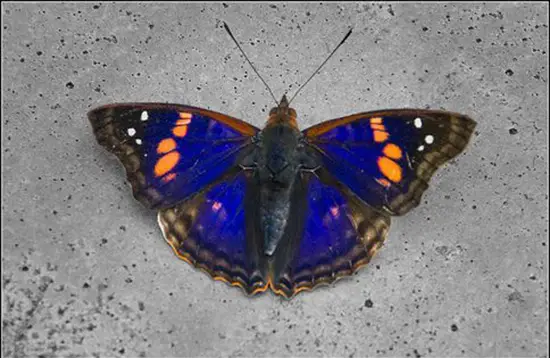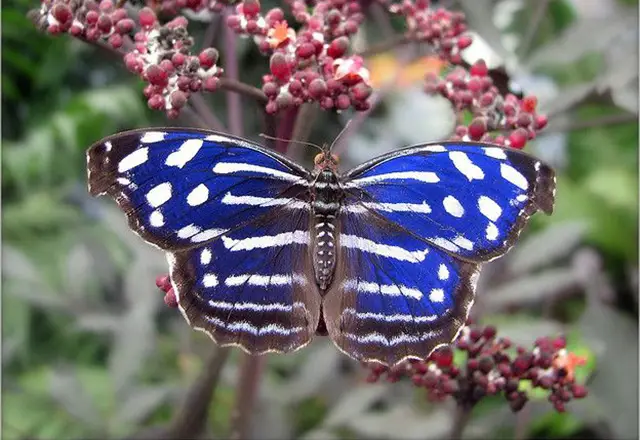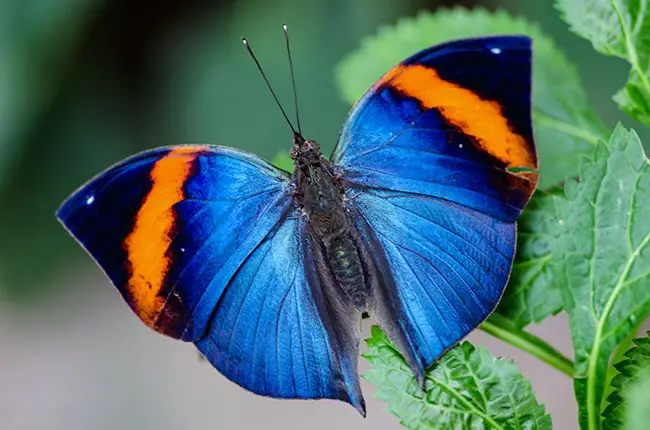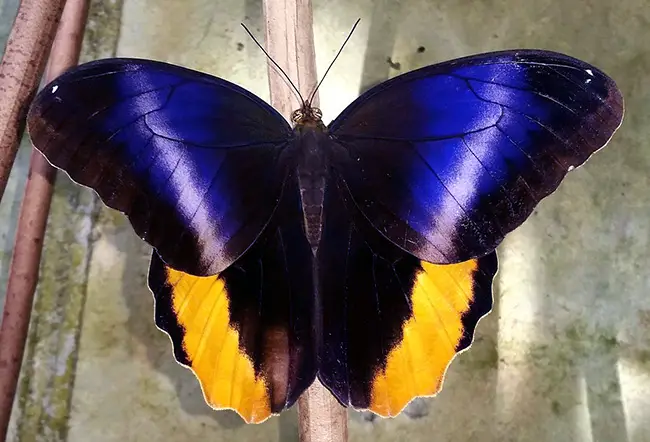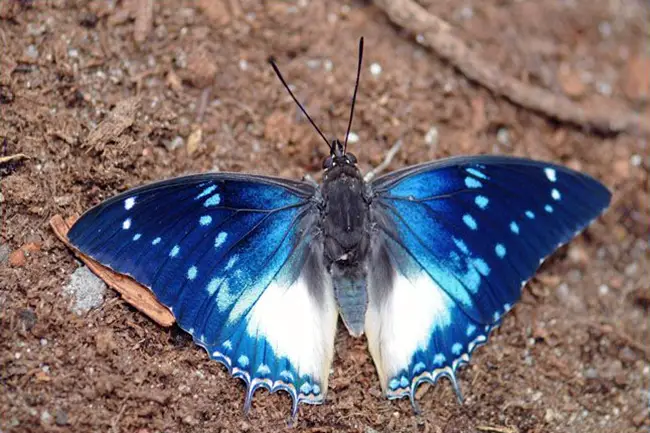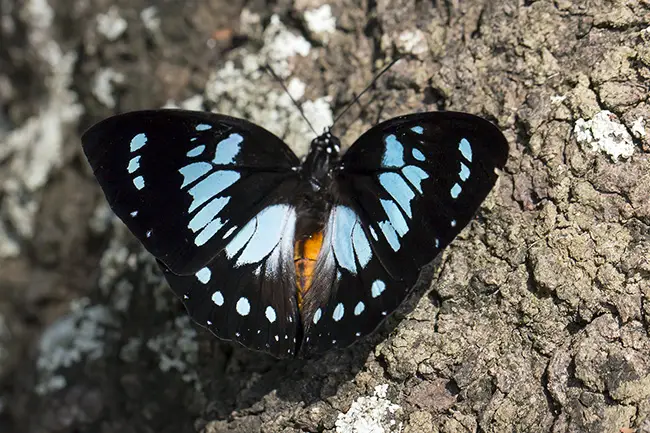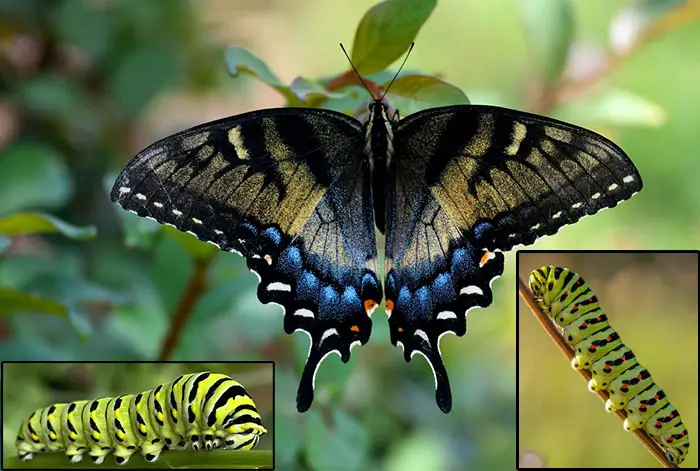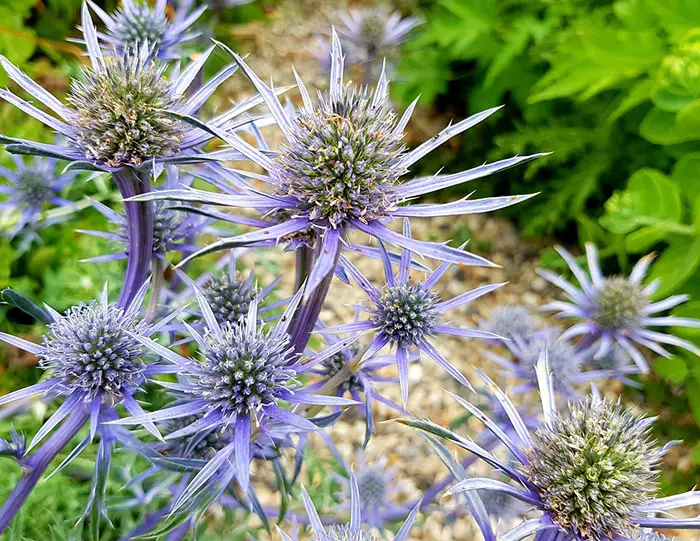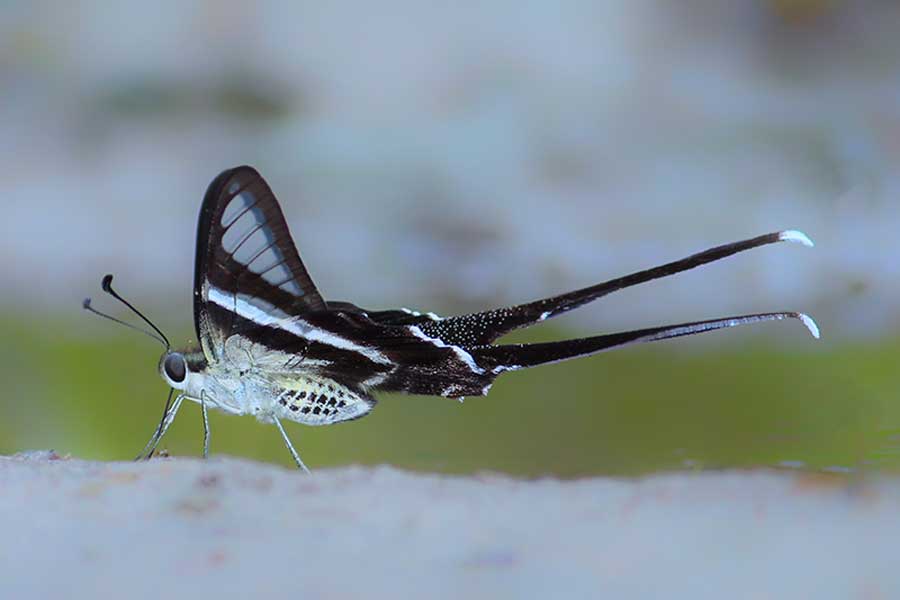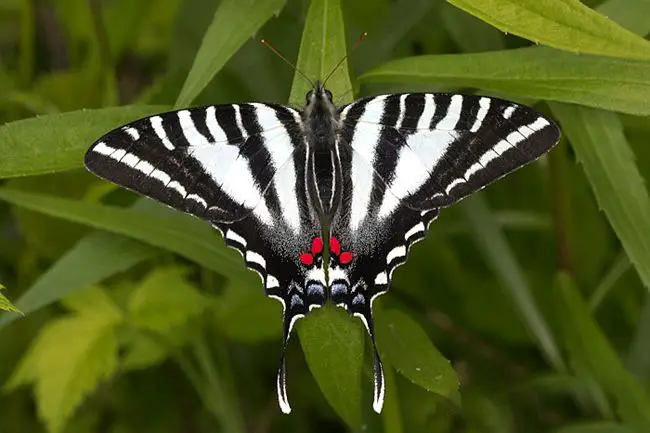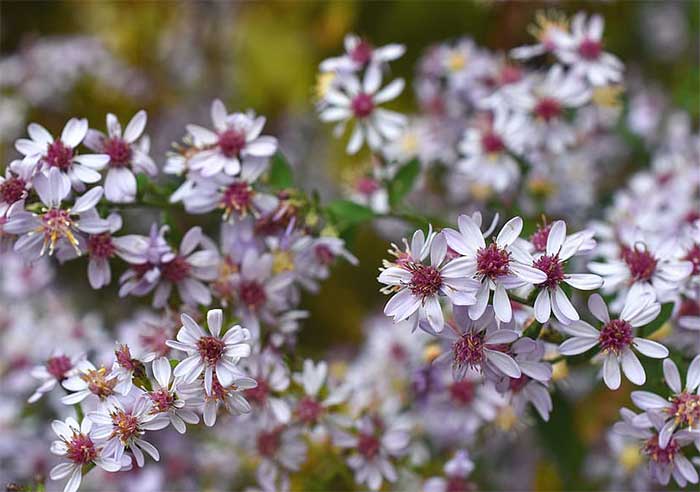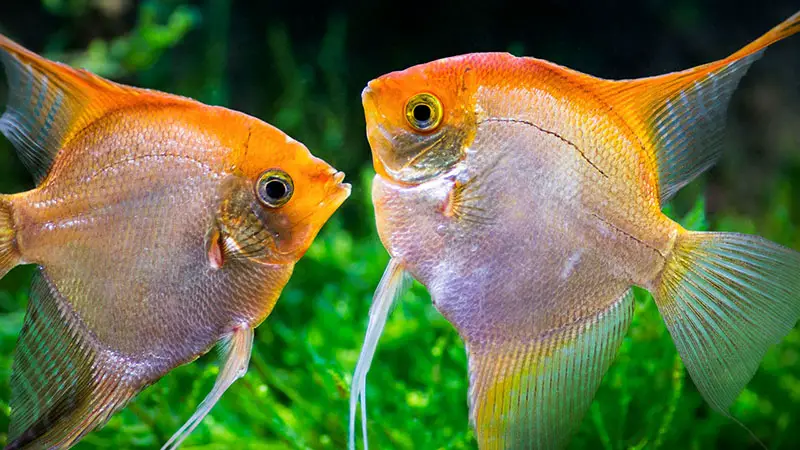Blue Butterfly species are one of the most colorful and eye-catching flying insects that you can observe in your home garden or backyard. Here is a list of a worldwide collection of beautiful blue color Butterfly species.
1. Giant Blue Morpho
Giant Blue Morpho or Morpho didius is among the world’s gigantic butterflies. The species belongs to the subfamily Morphinae or Morpho Menelaus of the family Nymphalidae. This blue butterfly has an iridescent blue coloration that looks so vivid on its large pair of wings. These wings can span up to eight inches. That’s actually a result of the microscopic scale reflection when their wings get exposed to light. Males have wider and brighter wings than females. They are native to tropical forests and are largely found in South American regions. However, this wonderful butterfly is currently endangered by deforestation and habitat fragmentation.
2. Rhetus Periander
Rhetus Periander is a remarkable butterfly with a blue sheen coloration on its upper wings with black borders on the four segments. Periander is the most common Rhetus species renowned for its short palpi. You can typically find this butterfly singly in a small group at the elevation of 0-1800m ASL. They usually inhabit the cloud forest and rainforest including throughout the tracks or near the rivers or streams. Rhetus Periander attracts Eupatorium flowers as well as some nectars. However, the males particularly have an interest in mineral salt and carrion. You may find males flying low above the ground and remain in one spot for a while. Because they may suck the mineral salt from the ground. Rhetus Periander is also known as Periander Metalmark.
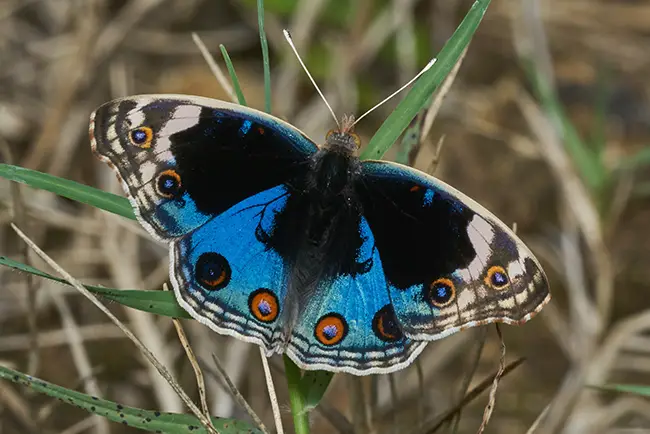
3. Blue Pansy
Blue pansy or Junonia orithya refers to diverse butterfly subspecies found in Africa, South East Asia, India, and Australia. The most common subspecies are Junonia orithya ocyale or Dark Blue Pansy and Junonia orithya or Pale Blue Pansy. Blue Pansy butterflies have electric blue on the upper wing with brownish coloration on the underwing. Wings are wide open under the sunlight. Males typically have a more vibrant color than females and have territorial behavior. The closer to the wing area, the eye-shaped spots get bigger that resemble the predator’s eyes. Despite being beautiful, these spots can also protect the butterfly from the natural predator that wants to prey on them.
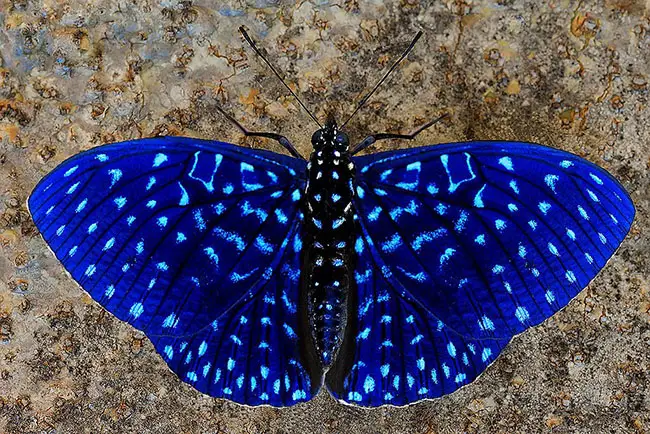
4. Blue Cracker
Blue Cracker or Hamadryas feronia exhibit beauty not only through their appearance but also through their sound. The “cracker” word refers to the sound the males produce to display their territorial behavior. When a male is entering another male’s territory, they’d produce this cracking sound to drive the intruder away. Well, the butterfly has a stunning mosaic pattern with bluish and brownish coloration in the wings that extends to the body. The wings are full of patterns but the blue Hamadryas is likely rarer than brownish or blackish crackers. Blue Cracker, like other Hamadryas butterflies, is largely present between June and September. Even though you can also find them flying all year.
5. Large Blue Butterfly
Phengaris arion or Large blue is a blue color butterfly species with black spots on the forewings, and pale brownish borders on all wings. While it has been declared extinct in Britain, Large Blue successfully conserved in other areas in Europe. Large Blue is actually a medium-sized butterfly where the blue coloration extends from its wings to its body. They are certainly larger than most blue color butterfly species. Regardless of the successful conservation, Pengharis arion is still an endangered species that can only observe in the reintroduced sites in the south of England. The butterfly also has a distinctive life cycle that also makes them not get along well with new environments.
6. Ulysses Butterfly
Ulysses Butterfly or also known as Papilio Butterfly is a large swallowtail butterfly as its wings can span up to 130 mm. This butterfly lives in the rainforest protection area. So you can largely find them in most tropical rainforest areas in South East Asia and Northern Australia. The iridescent blue coloration in their wings gets darker and intensified when reaching the edge and is black-bordered. However, you’d find them in black and brown when their wings folded. Ulysses Butterfly has a fast and erratic flight pattern. The striking blue color on the upper side is lined with black vines that blend with the blacked edge of the wings. This black and blue butterfly is one of the best examples of the observed colors of nature.
7. Adonis Blue Butterfly
Adonis Blue or Polyommatus bellargus is an entirely sky-blue colored butterfly where even the body is completely blue. It is very interesting that the bright blue wings and body only own by the males while the females tend to develop brown coloration. Both sexes have white borders on their forewings and lower wings. Adonis Blue has a fast and erratic flight pattern where you can find them flying lower over vegetation. They are small butterflies whose maximum wingspan is only 1.2 inches or 3 cm. You can largely see Adonis Blue flying around in its natural habitat during the summer season.
8. Blue moon Butterfly
The Blue moon butterfly or Hypolimnas bolina is a bluish-dark butterfly. This butterfly with tens of different species widespread in Asia, Australia, and Madagascar. The upper side has dominant black coloration with three pairs of blue-white spots on the fore and underwings. Females have brownish-black coloration but share similar patterns. The underside of both sexes has the same coloration as the upper side except they have white markings parallel to the edges. The Blue moon butterfly’s wings can span up to 3.3 inches. They have a slow yet erratic flight pattern. You can find this black butterfly with blue flying in their natural habitats including humid scrublands, green areas, lightly wooded deciduous forests, etc.
9. Blue Banded Eggfly
Blue Banded Eggfly or Hypolimnas alimena is a black butterfly with a blue band on its wings. You can also notice a double row of pale spots on the upper side. The underside is brownish with a smoky pale band. Blue Banded Eggfly is a nocturnal butterfly and is mostly dormant during daylight. They usually feed on Ganges Bluebell and can observe throughout the year. Blue Banded Eggfly’s wings can span up to 7 cm, making it a medium butterfly to observe. This butterfly largely lives in tropical northern Australia, New Guinea, Indonesia, and Soloman Islands. Blue Banded Eggfly has a fast and erratic flight style.
10. Blue Mormon
Blue Mormon or Papilio polymnestor is a large bluish butterfly with a wingspan of up to 15 cm. The upperside’s forewing hosts a band of blue scales. But males typically have brighter and more solid blue coloration than females. Their hindwings are almost solid blue in color except for some black patches and visible black veins. Blue Mormon has a fast and erratic flight with a powerful wing beat. They are mud puddles but won’t stay in the same spots for a while. Blue Mormon is a migrant species largely found in forest habitats. However, you may also find them in lush home gardens. They have quite widespread globally but you won’t likely find them in a handful of populations.
11. Pipevine Swallowtail
Pipevine swallowtail or Battus philenor is another American bluish butterfly species with the swallowtail. This butterfly has a bluish-green hue with but dominant blackish wing color even though not solid jet black. The underside hosts seven pairs of circular orange spots with bluish highlights in the hindwings. Pipevine swallowtail wingspan can reach up to 13 cm and they have a slow yet erratic flight style. Males usually have more intense coloration than females. But they both share a row of white spots on the tailed hindwings (upperside). Pipevine swallowtail is typically found in grassland, meadows, backyard, woodlands, or even gardens during the spring and summer months.
12. Pea Blue Butterfly
Pea blue or Lampides boeticus is a long-tailed blue small butterfly with purplish-blue coloration on the upper side. You can notice dark brown borders on the outer margins of their forewings. While males are bluish, females are brown in color. The underside has light brown coloration with a broad white band in the center. Pea blue inhabits tea plantations or hedge areas where they’re largely introduced. Pea Blue is a migratory species that fly no higher than shrub height. They may bask from the morning to midday during the cold weather. Pea blue might have subspecies in areas they have been reintroduced.
13. Janetta Themis Forester
Janetta Themis Forester is a brush foot butterfly from Africa and Southeast Asia. It has black coloration with bluish-yellow patterns and white tips on the wing edge. The underside of the wing is even more colorful with a yellow, blue, purple, black, and white mixture. That blends beautifully into patterns becoming visible when the wings closed. Janetta Themis Forester has some subspecies that have slightly different coloration but share similar patterns.
14. Clipper Butterfly
Clipper or Parthenos sylvia is a vibrant butterfly species with unique behavior. You can notice bluish grey and black patterns on their upper side with white patches and blacked veins. They may flap their wings stiffly when flying. The clipper has a fast yet erratic flying style. The forest-dweller butterfly usually has a slow and erratic flight even though it can actually fly fast whenever needed. Typically they live in the wet areas of the forest. Even though you might also find stray clippers in intermediate or dried zones. Clipper butterflies feed on the sap of fruits and flowers in their natural habitat.
15. Silver-studded Blue Butterfly
Silver-studded Blue is a small butterfly with silver spots and white edges on its hindwings and overall blue forewings. When closed, the underside reveals bluish-greyish gradients with scattered black spots and patterned black-yellow spots. Females have dark brown coloration with orange borders on the forewings. Silver-studded Blue is also known to have less mobility during its short life and spends most of its time on the host plants. This small butterfly largely exists in heathland and limestone grassland in Southern and Eastern Dorset. Silver-studded Blue is a pretty rare species due to its dependence on ants catering to their eggs.
16. Western Blue Beauty
Western Blue Beauty or Protogoniomorpha cytora is one of Africa’s most beautiful butterflies. It has radiant bluish-black and white coloration on the upper side. Western blue beauty is usually found singly or in a pair when basking on low foliage. This butterfly typically inhabits lowland forests and degraded forests, but you can also find them along roadsides. You can easily see their wings fully outspread and observe the patterns. Because western blue beauty is at head downwards posture most of the time. Today, the western blue beauty butterfly is Largely found throughout the West African forest belt including in primary forests and mature secondary forests.
17. Precis Octavia
The Gaudy Commodore or Precis octavia is an African and Asian blue butterfly species with around 20 subspecies widespread in the regions. As the endemic species, Precis octavia’s exact coloration would be subject to the particular environment they have been introduced to and the season. The rich blue upperside wings host the eight pairs of linear orange eyespots. Their coloration would typically get brownish when entering the wet season while the blue coloration intensifies in the wet season. You can even notice the blend of two coloration styles in the transition between dry and wet seasons. The Gaudy Commodore is largely found in sub-Saharan Africa while you also find them flying in some Asian countries.
18. Fender’s Blue
Fender’s Blue is a bold, painting-like butterfly with bluish wings. Their body has decorated with dark blue and white borders on the upper side. While the underside is generally greyish in color. It’s a subspecies of the family Lycaenidae endemic to the Willamette Valley of northwestern Oregon, US. Fender’s Blue is currently an endangered species and even once pronounced extinct. This butterfly inhabits the oak savanna and upland prairie. The disturbed native habitats are the main factor of the former Fender’s Blue extinction. They eat the nectar of various plants including Small camas, Narrow-leaf onion, Taper tip onion, Tolmie’s mariposa lily, Woolly sunflower, Clearwater cryptantha, and many more.
19. Baeotus Butterfly
Baeotus actually refers to a genus of American butterflies found in Central America, South America, and somewhere between. This is the most popular black and blue butterfly species from the Baeotus genus. Males have dark brownish upperside coloration with an appealing media band of blue scales on forewings and hind wings. Female Baeotus aeilus has a pale orange band pattern instead of blue. Baeotus’ wings can span up to 7.5 cm. They share a similar underside which has a white base color with black patterns and some orange marks on both forewings and hindwings. When closing their wings, Baeotus aeilus looks like a different species. Because the appearance of the wingspan posture is significantly different than the wings closed posture.
20. Holly Blue Butterfly
Holly Blue or Celastrina argiolus is a small butterfly with 14 subspecies. They are normally present in manmade environments like parks, gardens, woodland rides, hedgerows, etc. Regardless of particular differences, Holly Blue has varying shades of blue coloration with white wing borders. The underside of Holly Blue is pale blue or bluish-grey color with black spots unequally scattered. Males usually have brighter blue coloration. However, females have a black wing border instead of white. Holly Blue has a fast and erratic flight pattern while they would typically fly above our head height. Holly Blue lives in South Asia, India, Eurasia, and America.
21. Red-spotted Purple
The red-spotted purple is a North American brush-footed species that are also known as the White Admiral butterfly. Their upper side has a black base with a broad white band traversing forewings and hindwings. The underside is quite in contrast with a purplish orange-red base with black and white edges and dots. A red-spotted purple butterfly’s wings can span up to 3.5 inches. They have short flight patterns at low altitudes. You won’t likely find red-spotted purple flying more than three feet off the ground. This butterfly is largely found in shady areas of woodlands, forest edges, and roadsides, especially if they can find any deerberry and black cherry to feed on.
22. Atala Butterfly
Atala or Eumaeus atala is a bluish butterfly species native to Florida but reintroduced in Caribbean Islands. The upper side hosts Caribbean blue or iridescent teal coloration depending on the seasons. But females usually have brighter blue markings on the forewings and blue spots on the hindwings. Both have black vein-like patterns. Atala butterfly has an average wingspan of up to two inches. They have a slow and moth-like flight pattern that makes this butterfly more observable. The Atala butterfly is largely found in gardens, shrub areas, grasslands, and open woodlands. They breed throughout the year in the shrubby area with native or certain introduced plants.
23. Great Blue Hairstreak
Great Blue Hairstreak or great purple hairstreak (Atlides halesus) is a gossamer-winged butterfly species. The name “Blue Hairstreak” comes with the fact that the butterfly also has a blue pattern aside from the purple shade. The upper side has a black base with blue borders while the underside has dusky purple coloration. Females are typically less colorful than males when flying. A great blue hairstreak has an average wingspan of up to 51 mm. It has an active flight pattern extending from March to December. You can largely find great blue hairstreak in suburban or agricultural areas, oak woods, and mesquite forests, with American Mistletoe as the primary host plant.
24. Spicebush Swallowtail
The spicebush swallowtail is a North American butterfly species with a unique swallowtail. The upper side hosts black coloration with white spots on the fore wings. You can notice scaled bluish-green sheen and orange spots on the hindwings. Females are bluish while males are a bluish-green sheen so they can easily differentiate. The underside has pale green-colored marginal spots but still with black base. The average wingspan of a spicebush swallowtail is up to 4 inches. They’d typically fly low to the ground with relaxed flops that make them more noticeable. You can find spicebush swallowtails in the fields, wooded swamps, yards, parks, pine barrens, and even roadsides.
25. Purple Mort Bleu
Purple Mort Bleu or Eryphanis polyxena resembles the owl butterflies in terms of appearance except for the large eyespots on the outer of its hindwing. The underside hosts iridescent purple coloration which is the part you can observe most of the time. Purple Mort Bleu rarely open their wings. Therefore the upper side is considerably hard to find except if you view it in the photo. Purple Mort Bleu is largely found in North American and South American forests. Especially in the rainforest and humid deciduous forest. This butterfly usually consumes fallen fruits on the ground and they fly throughout the year.
26. Ceraunus Blue
Ceraunus Blue or Hemiargus ceraunus is a small butterfly species that is native to Central America and the South American region. The upper side hosts blue coloration with radiant black veins and white borders while the body is bolder blue. The underside host white bands with dark bars with gray base coloration. Ceraunus Blue has a wingspan of up to 25mm only. Therefore they are less observable in distance. Ceraunus Blue typically thrives in open spaces with direct sunlight. Such regions like scrubs, weedy fields, yards, disturbed sites, parks, and even roadsides. It is likely you have no difficulties in inviting Ceraunus Blue to your backyard.
27. Common Blue Butterfly
Common Blue is a small butterfly with bright blue wings belonging to the subfamily Polyommatinae and family Lycaenidae. Males have brighter blue with white fringes and brown borders on four segments. While females have brownish wings with blue sparks when closer to the body. Both have black spots and orange spots on the bottom side of the hindwings. It’s among the most widespread blue coloration butterfly species that you can find between April and October during the summer. They can brood 2-3 times over the spring and summer depending on the weather. You can plant nectar-rich borders, climbing ivy, and shrubs in your garden in an attempt to attract Common Blue.
28. Savannah Charaxes
Savannah charaxes or popularly known as the Scarce Forest Emperor or Charaxes etesipe are small-medium butterfly species native to Central Africa. They are so appealing with their blackish-blue coloration on their upperside’s forewings that enhance the greenish tint. You can notice the underside host cream and drab coloration. This butterfly’s wing can span up to 6 cm only but you can clearly observe the beauty. Savannah charaxes only broods once per year. You can expect to see them flying somewhere around March to June and August to October. Both sexes share a similar appearance except the females are generally larger than males.
29. Karner Blue Butterfly
Karner blue is another American small butterfly with bold coloration. The upper side of males hosts dark blue hues with greyish borders through forewings and hindwing. The underside has a band of orange crescent on the dull gray base coloration. You can also notice white borders and scattered black spots. Karner blue has an average wingspan of about one inch and it has fast haphazard flight patterns. You can find Karner blue in sunny fields where wild lupines robustly grow in the area. Since they are the primary host plant for this species where they also eat the flower nectar.
30. Prola Beauty
Prola Beauty or Prola panacea is a beautiful black turquoise butterfly species largely found in South America. This butterfly inhabits forests in lower altitudes throughout Brazil and Colombia. The upper side hosts reflective pale turquoise coloration with dark borders. Their contrast underside has a reddish-brown base color with black segmented lines. The butterfly is flying high up to 15 meters under the forest canopy. They are typically grouped in 50 butterflies to bask around the sandbanks for mineral-rich moisture. The reddish-brown underside is not only for a beautiful appearance. But it also delivers a signal to others when the group is threatened by predators or intruders.
31. Striped Blue Crow
Striped Blue Crow or Euoplea mulciber is a large butterfly largely found in Singapore. Male has brighter blue on the upperside’s forewing with the hindwing reddish-brown. Females have distinctive narrow white streak stripes on the upper side. Both share white submarginal spots over drably coloration on their undersides. The butterfly typically inhabits urban gardens, yards, parks, or anywhere with host plants. While it’s a common butterfly in the country you won’t likely find a handful of them in any of those habitats. However, they are certainly observable with a wingspan of up to 110 mm. They fly around areas with Indian Laurel, Sea Rubber Vine, or Oleander plants.
32. Starry Night Cracker
Starry Night Cracker or Hamadryas laodamia allows you to view starry nights in a small, moving scene. It’s one of 20 butterfly species that produce a cracking sound by twanging the spiny rods when taking off. They are native to Central and South America and rarely found on the ground. The upper side hosts the stunning calico pattern in the forewing with velvety black coloration, blue sheen, and bright blue spots as the pattern. Starry Night Cracker typically flies 10 meters above the ground. They spend most of their time basking while remaining in the same spots for hours for mineral-rich moisture. This black butterfly with blue is typically active from sunrise to sunset and spends the most time on tree trunks.
33. Mexican Bluewing
Mexican Bluewing or Myscelia ethusae is another bluish butterfly largely found in southern Mexico to Colombia. The upper side of the wings is black colored with multiple blue bands and tipped with white spots. You can notice the brownish-black underside that appears like dried leaves. The medium-sized butterfly’s wingspan is up to 3.0 inches. They consume fallen rotting fruits in their natural habitats. Mexican Bluewing butterflies can also observe in Texas, especially in the Lower Rio Grande Valley. The butterfly broods multiple times per year and you can meet a handful of populations in those areas.
34. Sapho Longwing
Sapho Longwing or Heliconius sapho is butterfly species found in Central America to South America. The upper side of the dorsal forewing has black on the outer radiant and dark blue on the inner radiant. You can notice the distinctive large white patch in the center while the hindwings are generally dark blue colored. Sapho Longwing butterflies fly under the canopy of the dense forest and consume a variety of nectar and pollen. They brood multiple times per year so you can expect them to fly all year round. Males have territorial behavior when mating and their main host plant is Passiflora pittieri.
35. Nicaraguan Emperor
Nicaraguan Emperor or Doxocopa calliandra is another South American blue butterfly species. They have iridescent blue upperside wings with brownish-black borders and white tips. The brown veins cross the bold blue coloration creating a stunning display. Their average wingspan is around 2-3 inches depending on the specimens. While females share similar shapes to males, they have brownish coloration on the upper side instead of blue. You can find Nicaraguan Emperor butterflies in Southern Mexico and Costa Rica. The Nicaraguan Emperor is one of ten Doxocopa or Neotropical butterfly species that share similar shapes and patterns. However, Doxocopa callianira has these appealing iridescent colorations competing with Doxocopa agathina and Doxocopa laurentia.
36. Tropical Blue Wave
Tropical Blue Wave or Myscelia cyaniris is a small butterfly species largely found in Central America and South America. They appear with bright blue coloration on the upper side of the forewings with visible white spots and crossing white transversal bands. The appearing coloration of the upper side would depend on the light reflection as you may see neon, sapphire, or dark blue on the dorsal view. The underside has cryptic coloration or like the dead leaf except the forewing copying the upperside’s pattern but in pale, cryptic coloration. Tropical Blue Wave inhabits rainforests at higher altitudes and consumes fallen rotting fruits.
37. Indian Leaf
Indian Leaf or orange Oakleaf or Kallima inachus is the orange-bluish butterfly species largely found in India to Japan or through the tropical Asia region. You can notice the orange stripe, deep blue hue, and blackish topmost point on the dorsal view of the forewings. Hindwings host a brown patched margin that borders the uniform blue pattern. The underside appears with cryptic coloration that looks like the dead leaves and allows them to camouflage. Indian Leaf has an average wingspan of up to 4.3 inches and they have fast and erratic flight patterns. Indian Leaf butterflies naturally fly during the dry and wet seasons.
38. Magnificent Owl
Magnificent Owl or Caligo atreus or yellow-edged owl is one of the most famous butterflies or Caligo and is among the world’s largest butterfly species. While Magnificent Owl shares similar black eyespots resembling owl’s eyes. This butterfly has a distinctive iridescent dark blue gradient on its dorsal. It may look similar to other owl butterflies when closing its wings but you’d see an amazing appearance when the wings are open. Hind wings have bright yellow coloration that contrasts but blends well with the fore wings. Magnificent Owls spend most of their time basking in the shade or consuming fruits. This butterfly is largely found in tropical forests of Central and South America.
39. Blue-spotted Charaxes
Blue-spotted Charaxes or Charaxes cithaeron are African butterfly species. The dorsal view hosts blue spots over the black-colored base. But with a dominant white area with a bluish border in the hind wings. The underside has a brownish base with yellowish tips and spots. Blue-spotted Charaxes are largely found in the Southern Africa region, especially in those evergreen forests. Living up to 10 days, this butterfly usually consumes fermenting fruits when grown up as adults. You can expect Blue-spotted Charaxes to fly all year round. Their host plants include Trema Orientalis, Albizia adianthifolia, Celtis africana, and Craibia brevicaudatus.
40. Forest Queen
Forest Queen or Euxanthe wakefieldi is another African butterfly species that specifically inhibits forest areas where sunlight can penetrate through the tree canopy. The dorsal view of Forest Queen exposes the upperside’s black coloration with bluish patterns and spots both on the forewings and hind wings. Male butterflies are territorial when mating that start as females enter their zone. Forest Queen butterflies love to eat tree sap and ferment fruits as when growing up as adults. While males and females look similar in shape. But females usually have larger patches on the underside of their hind wings. It is still not clear yet the flight period of Forest Queen in their natural habitat.


